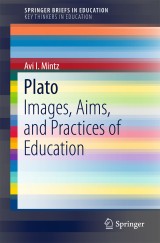Details

Plato
Images, Aims, and Practices of EducationSpringerBriefs in Education
|
53,49 € |
|
| Verlag: | Springer |
| Format: | |
| Veröffentl.: | 08.03.2018 |
| ISBN/EAN: | 9783319758985 |
| Sprache: | englisch |
Dieses eBook enthält ein Wasserzeichen.
Beschreibungen
<p>This book opens by providing the historical context of Plato’s engagement with education, including an overview of Plato’s life as student and educator. The author organizes his discussion of education in the Platonic Corpus around Plato’s images, both the familiar – the cave, the gadfly, the torpedo fish, and the midwife – and the less familiar – the intellectual aviary, the wax tablet, and the kindled fire. These educational images reveal that, for Plato, philosophizing is inextricably linked to learning; that is, philosophy is fundamentally an educational endeavor. </p><p>The book concludes by exploring Plato’s legacy in education, discussing the use of the “Socratic method” in schools and the Academy’s foundational place in the history of higher education. </p><p>The characters in Plato’s dialogues often debate – sometimes with great passion – the purpose of education and the nature of learning. The claims about education in the Platonic corpus are so provocative, nuanced, insightful, and controversial that educational philosophers have reckoned with them for millennia. </p><div><br></div><p></p><p></p><p></p><p></p><p></p>
<p>1. Plato as Student, Plato as Teacher.- 2. Varieties of Educative Experiences in Classical Greece.- 3. Philosophical Education in the Platonic Corpus.- 4. Plato’s Educational Images.- 5. The Socratic Method: Plato’s Legacy in Pedagogy.- 6. Higher Education and Plato’s Academy in Classical Greece.</p><p></p>
<p>This book opens by providing the historical context of Plato’s engagement with education, including an overview of Plato’s life as student and educator. The author organizes his discussion of education in the Platonic Corpus around Plato’s images, both the familiar – the cave, the gadfly, the torpedo fish, and the midwife – and the less familiar – the intellectual aviary, the wax tablet, and the kindled fire. These educational images reveal that, for Plato, philosophizing is inextricably linked to learning; that is, philosophy is fundamentally an educational endeavor. </p><p>The book concludes by exploring Plato’s legacy in education, discussing the use of the “Socratic method” in schools and the Academy’s foundational place in the history of higher education. </p><p>The characters in Plato’s dialogues often debate – sometimes with great passion – the purpose of education and the nature of learning. The claims about education in the Platonic corpus are so provocative, nuanced, insightful, and controversial that educational philosophers have reckoned with them for millennia. </p><div><br></div> <p> </p>
Introduces readers to Plato’s multifaceted contributions to educational theory and practice Explores his dialogues and his legacy Describes and explains some of Plato's key educational images Provides an overview of the diverse ways that the “Socratic method” has come to be practiced in schools
<div><br><div><br></div></div>
<p>“Mintz weaves in Plato's biography into his philosophical aspirations, portraying a philosopher with a profound practical and philosophical interest in education. This is a refreshing and original contribution because it invites the reader to ask whether Plato's metaphysical views are in fact metaphysical doctrines or rather creative and innovative expressions of philosophical ideas about moral transformation and education. The book also provides a treasure trove of helpful references pertaining to Plato's thoughts about education which will surely prove useful to a broad range of readers of Plato.” (Yoshiaki Nakazawa, Valparaiso College, USA)</p>
<p> </p>
<p> </p><br>
<p> </p>
<p> </p><br>
Diese Produkte könnten Sie auch interessieren:

Cybermobbing in der Schule. Interventions- und Präventionsmaßnahmen, Erscheinungsformen sowie Ursachen

von: Katharina Zyban

13,99 €

Wirksamkeit digitaler Medien in der Schule anhand des Einsatzes von Tablets

von: Christian Rode

29,99 €

Erfolgreich als Lehrkraft starten für Dummies

von: Carol Flaherty, Flirtisha Harris, W. Michael Kelley

21,99 €













